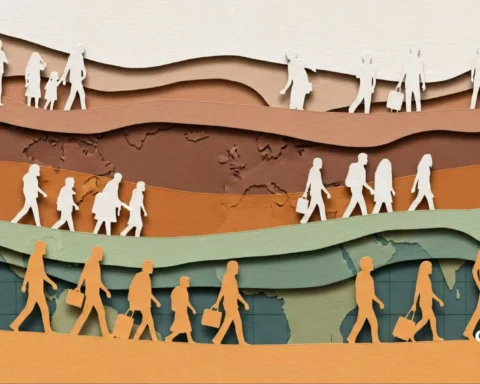Nestled amidst the lush green landscapes and serene beauty of the Indian subcontinent, the Northeast Indian culture holds much significance. Comprising eight states, this remote and enchanting corner of the country holds an astonishing blend of traditional lifestyles, artistic expressions, and an awe-inspiring natural environment within its boundaries. Over the 20th century, the Northeastern region emerged as a hub of cultural exchange, preserving its distinct culture and rich heritage while embracing modern influences.
Table of Contents
Geographical and Cultural Overview
The North East Indian region is characterised by its rugged terrain, abundant rivers, and lush greenery. The North Eastern region encompasses eight states. These states are bordered by neighbouring countries like Bhutan, China, Myanmar, and Bangladesh, contributing to the diverse cultural influences present in the region.
Historical Significance
The history of Northeast India is intertwined with various kingdoms, migrations, and colonial interactions. The region has been a melting pot of cultures, with each state holding its historical significance. From the Ahom Kingdom of Assam to the Naga and the struggle of the Mizo tribal people for self-determination, the history of the North East is a tapestry of resilience and diversity.
Cultural Diversities in the Region
The Northeast region in the Indian Subcontinent is a mosaic of various ethnic groups and indigenous communities, each contributing to the rich tapestry of North East India’s cultural heritage. From the hilly terrains to the dense forests like temperate forests and deciduous forests as well as Alpine forests and subtropical forests, the people of the Northeastern region have nurtured their rich culture and traditions, including the heritage of folk music, heritage of folktales, dances, and handicrafts, which reflect their deep connection with nature.
Ethnic Groups and Indigenous Communities
Northeast India is home to numerous indigenous tribes with distinct languages, customs, and traditions. These communities have lived in harmony with nature for centuries and have preserved rich culture, such as the heritage of folk music and the heritage of folktales, and their way of life through oral traditions and practices.
Traditional Customs and Lifestyle
The daily life of North East India’s people is marked by rituals, ceremonies, and customs that reflect their close connection to nature. From the unique bamboo architecture to traditional clothing and food habits, the region’s customs offer a glimpse into its rich cultural fabric.
Festivals and Celebrations
Festivals in Northeast India are vibrant expressions of community bonding and cultural heritage. Bihu in Assam, Hornbill Festival in Nagaland, and Sangai Festival in Manipur are just a few examples of the region’s colourful celebrations that showcase its diversity.
Traditional Music and Performing Arts
The melodious echoes of folk dances, folk songs and the rhythmic beats of traditional instruments resonate throughout the Northeast region. The region’s unique musical heritage is closely intertwined with the daily lives of its people. Whether it’s the Bihu dance of Assam or the Cheraw dance of Mizoram, these art forms serve as a medium to celebrate life’s joys and the bounties of nature.
Folk Songs and Their Themes
Folk songs and dances reflect the region’s history, myths, and everyday life. These genres of music, accompanied by traditional instruments, narrate stories of love, bravery, and community. The Bihu songs of Assam and the Cheraw songs of Mizoram are prominent examples.
Musical Instruments of the Region
Traditional instruments like the dhol, pepa, and bamboo flutes play a crucial role in Northeast India’s genres of music and performing arts. These instruments not only produce melodious tunes but also serve as cultural symbols.
Role of Music in Everyday Life
Music is deeply ingrained in people’s daily lives in the Northeast region. From lullabies to work songs, music accompanies various activities, creating a harmonious connection between the people and their environment.
Breathtaking Natural Beauty
The easternmost region of India is a haven for nature enthusiasts, boasting a diverse range of ecosystems that include temperate forests, deciduous forests, pristine river valleys and mountain ranges. The region’s natural beauty is an unending source of inspiration for its artistic and cultural expressions. The landscapes have not only shaped the lifestyle of the inhabitants but have also played a significant role in influencing their creative endeavours with their scenic beauty.
Ecological Diversity of Northeast India
The region’s scenic beauty and diverse landscapes, ranging from mountain ranges and mountain peaks to tropical rainforests, contribute to its ecological richness. This diversity has nurtured a wide array of plants, including medicinal plants and animal species found nowhere else in the world.
National Parks and Wildlife Sanctuaries
The Northeastern region boasts a wide variety of national parks and wildlife sanctuaries, such as Kaziranga National Park and Manas National Park. These protected areas are crucial for the conservation of endangered species like the Indian rhinoceros and Bengal tiger.
Impact on Art and Culture
The stunning natural beauty of Northeast India has influenced its art, literature, and performing arts. Artists draw inspiration from the landscapes, flora, and fauna, creating works that reflect the region’s intrinsic connection to nature.
Tribal Culture and Heritage
The tribal culture of North East is as distinct as it is captivating. With each tribe having its own set of customs, languages, and rituals, the region showcases a remarkable assortment of cultural heritages. The tribal people have retained their age-old practices, passing them down through generations and enriching the tapestry of Indian culture.
Indigenous Tribes of Northeast India
The region is a melting pot of indigenous tribes, each with its language, beliefs, and practices. Tribes like the Khasi, Naga, and Mizo have preserved their unique identities despite historical challenges.
Rituals, Beliefs, and Traditions
The rituals and beliefs of Northeast Indian tribes are deeply intertwined with their natural surroundings. These practices often centre around agriculture, hunting, and ancestral worship, reflecting their symbiotic relationship with the environment.
Oral Narratives and Folklore
Oral traditions are a vital aspect of tribal culture, with stories, myths, and legends passed down through generations. These narratives entertain and transmit important cultural values and historical knowledge.
Unique Dance Forms of the Northeast Indian Culture
Dance in North East is a celebration of life and a portrayal of various emotions. The classical dances of the region, such as Manipuri and Sattriya, are steeped in history and spirituality. These dance forms serve as a medium of entertainment and a way to connect with the divine. The intricate movements, vibrant costumes, and soul-stirring music make these dances a sight to behold.
Classical Dances: Manipuri and Sattriya
The classical dance forms of Manipuri and Sattriya are rooted in the religious and spiritual contexts of the North East. Manipuri dance narrates stories from Hindu mythology, while Sattriya dance is associated with the Vaishnavite monasteries of Assam.
Traditional Dance Forms of Different States
Each state in Northeast India boasts a unique repertoire of traditional dance forms. From the Aji Lamu dance of Arunachal Pradesh to the Cheraw dance of Mizoram, these art forms celebrate community, nature, and life.
Symbolism and Cultural Significance
Dance in Northeast India is not just a form of entertainment; it’s a language that conveys emotions, stories, and cultural values. The intricate footwork, elaborate costumes, and rhythmic movements hold deep symbolic meanings.
Prominent Literary Figures of Northeast India
The literary landscape of Northeast India has been adorned with the contributions of remarkable individuals who have used their pens to reflect the region’s diverse cultures, histories, and aspirations. These literary figures have enriched the literary world and shed light on the intricate tapestry of the North East. Among them, Birendra Kumar Bhattacharya stands as a distinguished name, with his works resonating with the ethos of the region.
Life and Works of Birendra Kumar Bhattacharya
Birendra Kumar Bhattacharya, a literary award-winning luminary of Northeast India, has contributed significantly to the region’s literature. His works delve into the complexities of the area, capturing its social, political, and cultural nuances.
Themes and Reflections of Northeast India
Bhattacharya’s writings often explore themes like identity, displacement, and cultural assimilation of the North East. His stories reflect the struggles and aspirations of the people of Northeast India in a rapidly changing world.
Influence on Literature and Society
Birendra Kumar Bhattacharya’s literary contributions have highlighted the region’s unique cultural challenges and strengths. His works have influenced subsequent generations of writers and intellectuals.
Preservation of Cultural Heritage in the 20th Century
The 20th century has witnessed significant changes in the dynamics of North East India. While modern influences seeped into the region, there was also a conscious effort to preserve the unique cultural heritage. Various institutions, organizations, and individuals worked tirelessly to document, promote, and protect the traditional art forms, languages, and customs, ensuring that the essence of North East India continues to thrive.
Modernisation and Cultural Identity
The 20th century brought opportunities and challenges to Northeast India’s cultural heritage. Modernisation and globalisation posed the risk of diluting traditional practices, prompting efforts to strike a balance between cultural preservation and progress.
Role of Government and NGOs
Various governmental initiatives and non-governmental organizations have played a pivotal role in documenting, promoting, and safeguarding Northeast India’s cultural heritage. This collaborative effort has helped raise awareness about the region’s unique identity.
Challenges and Future Prospects
Despite efforts, challenges such as urbanization, language shifts, and climate change continue to impact North East India’s cultural heritage. Sustaining these efforts in the face of changing circumstances is crucial for the region’s cultural vitality.
Conclusion
The Northeast Indian culture, with its enchanting landscapes and cultural kaleidoscope, is a true testament to India’s diversity. The region’s tribal communities, classical dances, traditional music, and literary contributions have woven a rich tapestry that adds to the country’s cultural mosaic. As North-East India moves forward, its unique heritage must be cherished, preserved, and celebrated within its borders and on the larger global stage.
FAQs
What is the culture of the Northeast?
The culture of Northeast India is a diverse tapestry woven with rich traditions, indigenous practices, and vibrant festivals. This region boasts a unique blend of tribal heritage, classical performing arts, and close harmony with nature, creating a cultural mosaic that celebrates both the ancient and the contemporary.
Who are the indigenous people of Northeast India?
North East India is home to a myriad of indigenous tribes, each with their distinct languages, customs, and traditions. Some of the prominent indigenous communities in the region include the Khasi, Naga, Mizo, Bodo, Garo, Manipuri, and many more.
What food is the Northeast known for?
Northeast India is renowned for its distinctive and varied culinary heritage. Some popular foods include bamboo shoot-based dishes, smoked meats, fermented foods, fish curries, Assam tea, rice-based dishes like pithas, and iconic snacks like momos (dumplings).
Which is the oldest tribe of the Northeast?
The Khasi tribe is often considered one of the oldest indigenous tribes in Northeast India. The Khasi people primarily inhabit the state of Meghalaya and parts of Assam, and their culture and traditions have deep roots in the region.









